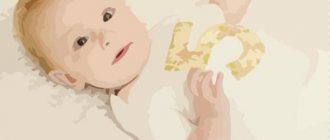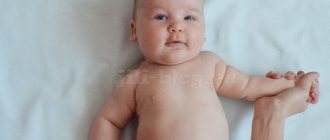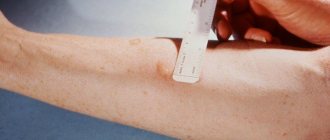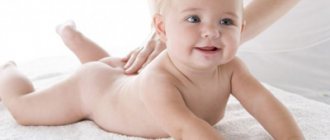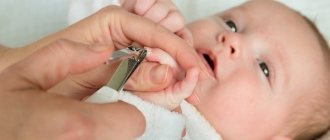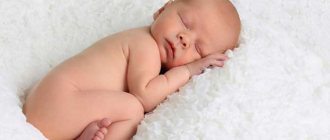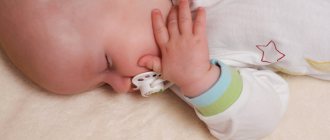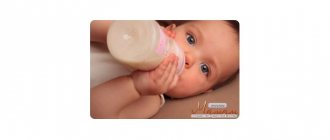Goals of speech therapy massage
Logomassage is a set of effective techniques that helps a child learn the correct pronunciation of sounds. This method involves systematically performing certain exercises throughout the course of speech therapy treatment, as a result of which the muscles involved in speech become more active and work more productively.
Logomassage for children at home or in a medical facility is prescribed by a specialist on an individual basis. For each patient, specific exercises are selected that target one or another group of facial muscles.
Types of logomassage for children
The purpose of speech therapy massage is to teach the child the skills to control facial muscles. During classes, the muscles of the oral cavity and face used in speech alternately relax and then become toned.
Massage produces a beneficial physiological effect on the entire body, improving the secretory functions of the skin, activating the outflow of blood and lymph. Thanks to logomassage, metabolic processes and tissue trophism are stabilized. During the procedures, the blood vessels dilate slightly, which is why oxygen reaches the cells much faster.
In addition to these advantages, it is worth noting that speech therapy massage affects muscle tissue, making it more elastic and efficient. This has a positive effect on their contractile function and the rate of activity recovery after exercise.
We perform speech therapy massage of the child’s tongue at home
It is necessary to plant/put the offspring in a position that is comfortable for it. Following the rules of hygiene, you can begin the procedure.
Technique:
- Direction: from the tip of the tongue, with light movements, you need to “draw lines” to the zone that ensures the formation of the gag reflex.
- During the procedure, you should stroke your tongue, gently pat it, and create a feeling of vibration (no more than 15 seconds).
Conditions and technique
A brief description of several massage techniques:
- It is necessary to find the submandibular fossa and perform “acupressure”. Time - 15 seconds. The movements should be carried out with the index finger and resemble a slight vibration;
- The tongue is vibrated at the angles of the jaw for 15 seconds. It's worth using both hands;
Types of actions:
- Circular.
- Manipulations resembling spiral movements.
Exercises you can do at home
- Light lip massage;
- Facial massage;
- Vibration manipulations for the tongue;
- Movements from the chin to the part of the face located below;
Speech therapy massage for children
Determining the goals of speech therapy massage for children
The main goal of massage is to strengthen the muscles of the face and tongue, tone the speech apparatus, and get rid of congenital/acquired pathologies and defects.
This procedure also helps improve articulation and restores weakened jaw muscles.
Important! Before starting the manipulations, a conclusion from a speech therapist is required, who has established an accurate diagnosis. Making decisions on your own in such a situation is a rash act that can aggravate the situation.
Features of logomassage
First of all, the speech therapist determines the overall level of development of the baby. After the analysis, the motor skills of the hands and the work of the muscles responsible for articulation are assessed.
Then, if any deviations are detected, a specially selected set of exercises is prescribed. Performed at home or in a specialist’s massage room.
Speech therapy specializes in such problems, so there is no need to worry. The doctor knows exactly what needs to be done.
Before starting any procedure, you should make sure that the conditions meet all hygiene standards. Each specialist must have an individual kit and antiseptic.
Important! Logomassage is not prescribed without an appropriate diagnosis.
Features of tongue massage for children diagnosed with delayed speech development
Most often, the diagnosis “Delayed speech development” occurs in children suffering from cerebral palsy, experiencing problems with the central nervous system, and so on.
It is necessary to massage the tongue of children with delayed speech development every 1-2 months. This helps relieve muscle spasms and reduces salivation. Overall health is improving.
Tongue massage with fingers
Movements are performed carefully from the tip to the middle of the tongue. The sides and edges are ironed. Spiral/circular movements should not cause discomfort to the patient. If the child complains of pain, you should stop manipulation until next time.
Tongue massage (speech therapy) for a child can be performed at home without any special expenses.
Note! If pain does not go away, you should immediately consult a doctor.
Indications
Physical effects on the muscles of the face and oral cavity in the form of speech therapy massage are indicated in the absence of articulation motor skills and poor mobility of facial muscles, tongue, and cheeks. Thus, exercises are recommended not only for children, but also for adults (for example, after a stroke or traumatic brain injury).
The main indications for logomassage at an early age:
- dysarthria, in which the innervation of the speech apparatus is disrupted;
- rhinolalia caused by defects in the structure of the ligaments and muscles of the oral cavity;
- dyslalia due to a shortened hyoid ligament;
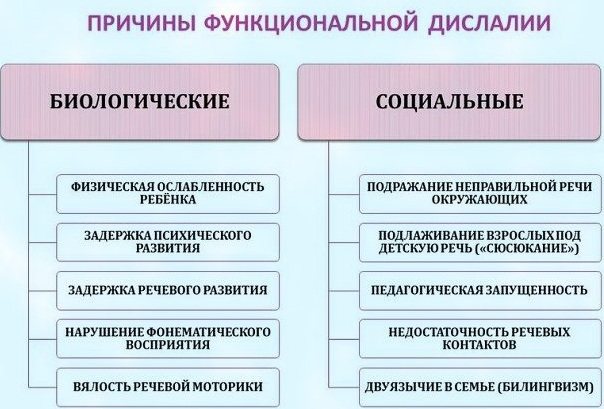
- birth injuries;
- congenital defects of the oral cavity, lips, tongue;
- stuttering;
- cerebral paralysis.
Most often, logomassage is performed on children with dysarthria. Difficulties in pronouncing individual sounds are often caused by damage to the posterior frontal and subcortical brain structures.
With timely correction, this problem can be easily eliminated. In order to give the child correct articulation for this diagnosis, speech therapists often prescribe treatment programs according to the methods of doctors Arkhipova, Dyakova, Novikova.
The second common reason for taking a course of logomassage is cerebral palsy (CP). With an increase in general muscle tone, the child experiences difficulties not only in terms of physical activity, but also in verbal communication.
Also, logomassage can be used as an element of a rehabilitation program after surgical treatment of physiological defects of the oral cavity and maxillofacial area (cleft lip, cleft palate, short frenulum). Before starting speech therapy treatment, the child should consult a neurologist to obtain a conclusion about the absence of contraindications.
Limitations and precautions
Despite the fact that speech therapy massage is an effective and safe auxiliary method of therapy for speech disorders, there are contraindications to its use.
Doctors include:
- epilepsy;
- infectious diseases (respiratory viral, dermatological);
- stomatitis;
- lymphadenitis;
- conjunctivitis.
The lesson is stopped if the child develops chin tremor and the nasolabial “triangle” begins to turn blue. Also, you should not do a massage if you have an elevated body temperature or general malaise.
Important rules of logomassage and conditions for doing it at home
Massage sessions for a child can be carried out independently, subject to a number of conditions.
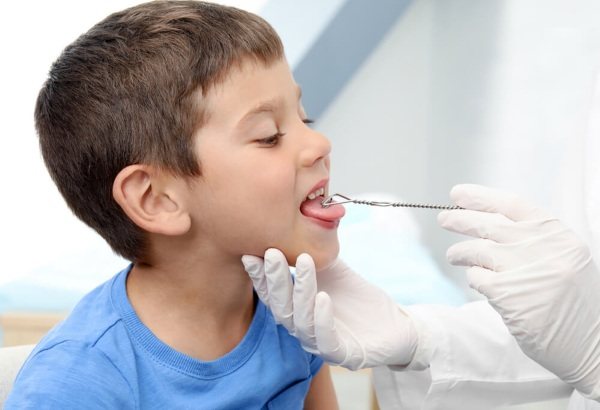
The most common recommendations for practicing at home are:
- Consultation with a speech therapist. It is advisable that the massage be performed for the first time by a specialist or the parent himself, but under the supervision of a doctor.
- Compliance with the regime. The procedure is not carried out if less than 2 hours have passed since the last meal.
- Preparing for the session. Before a massage at home, it is necessary to ventilate the room and perform the necessary hygiene procedures.
- Body position. During classes, the child can choose a lying position or a semi-sitting position.
- A combination of several techniques. During classes, you should combine exercises for several parts of the articulatory apparatus (lips, palate, lower jaw, tongue) at once, alternating movements. Speech therapy massage involves patting, stroking, pinching, zigzag and spiral influences.
- Warm up. Logomassage should always begin and end in the same way - with stroking.
- Frequency of exercises. Each movement is repeated at least 7-10 times. Perform at least 5-7 exercises in one session.
- Duration of the procedure. At the initial stage, at least 5 minutes are allotted for the session, gradually increasing the time to 15-20 minutes.
- Schedule. Classes should be conducted as prescribed by a speech therapist-speech pathologist daily or every other day for 20-30 days. The course can be repeated several times, but each time you should take a break of 2-3 months.
- Monitoring the child's condition. During the session, you need to carefully ensure that he does not experience discomfort, fatigue, or pain.
Logomassage for children at home can provide a noticeable breakthrough in speech development, but do not neglect systematic visits to the doctor, who should note the dynamics of changes and make adjustments to the treatment plan.
Doing a facial massage yourself to develop speech
Speech therapy massage for children can be performed at home. To do this, you need to master several therapeutic techniques that will stimulate the child’s speech apparatus.
Massaging is carried out:
- Lip;
- Language;
- Faces;
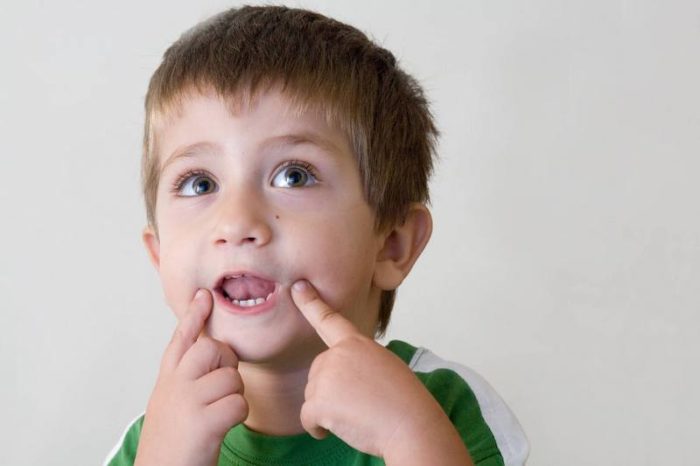
Carrying out logomassage
The necessary areas are massaged using circular movements. Sudden movements are excluded. Facial massage for children for speech development is performed using several simple techniques.
Doctors strongly do not recommend carrying out any manipulations without a doctor’s prescription. Otherwise, it can only make the situation worse.
Indications for logomassage
There are a number of indications for which massage is prescribed:
- Drooling (uncontrollable);
- Disease "Dysarthria";
- Pathologies of the development of the speech apparatus;
- Speech/voice impairment or partial loss;
- Too much tension in which the facial muscles are constantly located;
- Stuttering during speech;
- Tension of the facial muscles with a pathological bias, which complicates the pronunciation of any words;
- The presence of cerebral palsy in a child;
- Insufficient development of muscles that provide clear articulation;
- Tartar, other diseases of the oral cavity;
- Other pathologies and problems that arise during pronunciation. Also ZRR;
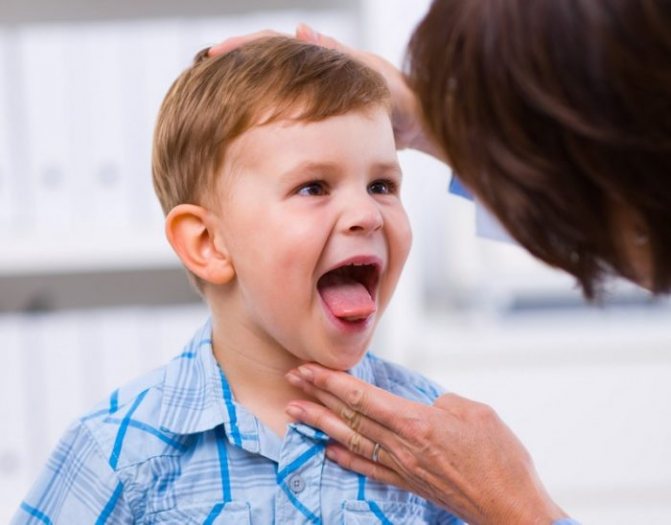
At an appointment with a specialist
These problems can occur both in healthy children and in individuals with various developmental disabilities. Massage is mainly prescribed for those who have congenital pathologies, as well as other serious problems with the speech apparatus.
It is necessary to contact a doctor in time; under no circumstances should you delay. If a mother notices that her offspring has such problems, she should immediately make an appointment with a specialist.
Important to know: there are contraindications
Massage therapists have established a number of contraindications under which this procedure is prohibited:
- Colds;
- The presence of herpes on parts of the face or lips;
- Ophthalmological diseases;
- Inflammation in the oral cavity;
- Presence of acute respiratory infections, acute respiratory viral infections;
- Injured tongue;
- Disease of the lymph nodes;
- Increased pressure inside the skull;
- Fungal viruses on the skin;
- Tuberculosis (active);
- Various oncological complications or diseases;
- Epilepsy/seizures;
- Diseases of blood vessels (capillaries);
- The presence of hematomas in a certain area of the body;
Card file of games on speech development for the 2nd junior group of preschool educational institutions
Procedures can be done no earlier than 10 days after complete recovery. The body must recover from the stress suffered from the disease.
What is the duration and frequency of procedures?
There are deadlines for this procedure that must be adhered to. Depending on the severity of the disease, the duration and frequency of health-improving manipulations may have different intervals (in time).
Standard massage: 10-20 sessions, performed daily or every other day. It is necessary to take a break for 1-2 months, then, if necessary, it is worth resuming the procedures. It is worth building a strict schedule throughout the year.
The best way to ensure you don't miss anything is to create a schedule that includes time slots for logomassage.
Initial stages: 1-6 minutes from the very beginning, then you can increase the time to 20 minutes.
Children's age - time: no more than 10 minutes, for preschoolers - no more than 15, schoolchildren - up to 25 minutes.
Hygienic conditions for carrying out logomassage at home
Before starting a speech therapy massage, you should ventilate the room so that the child is comfortable. If any instruments are used in the process, they must be thoroughly disinfected in a solution (chlorhexidine) or in boiling water.
Hands must be washed with special bactericidal soap to avoid introducing bacteria into the child’s mouth.
Important! Do not carry out manipulations in a dirty room.
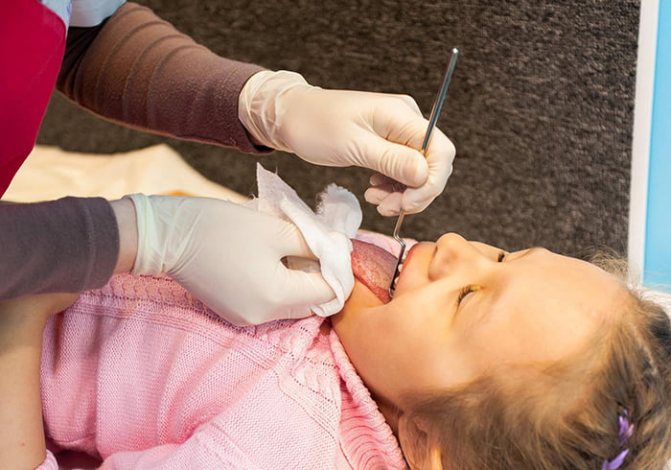
Tongue Massage Tools
Let's summarize the results of the work
After the work, the patient should not feel discomfort. If everything is done correctly, this will stimulate the speech apparatus. Then everything will be good.
Types of massage
By using several different massage techniques at once, as a rule, muscle tone decreases faster and spasms are eliminated. Logomassage helps muscles adapt to active voluntary or coordinated movements.
It is important to take into account that the body’s reaction to massage is directly dependent on the strength of the impact. For example, when stroking, the excitability of the massaged area is minimized, but when beating or pinching, on the contrary, it increases.
In practice, modern speech therapists use several massage techniques for children with problems in speech development.
Classic massage
Based on the name, it is easy to guess that traditional massage techniques are used here.
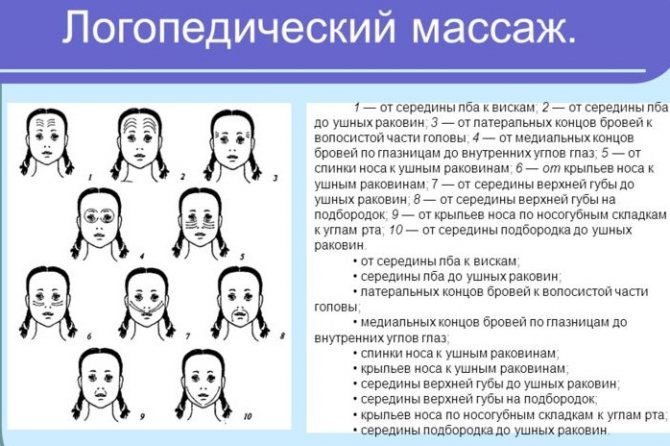
The person who works with the child uses:
- rubbing;
- stroking;
- kneading;
- pats that create vibration.
These 4 basic techniques can be classified according to the force of impact and speed of movement. So deep and slow ones relax the muscles, and fast and superficial ones increase its tone. To relieve spastic syndrome, strong vibration and stroking are used.
Hardware massage
Logomassage of this type for children, as a rule, is not carried out at home, since it requires the use of special equipment. The hardware method of treating speech disorders is one of the most effective. The massage device is equipped with various attachments for vibration and vacuum stimulation of the child’s articulatory apparatus.
Such devices can act on surfaces with different forces, depending on the set mode. Before each use, the device attachments should be treated with a disinfectant solution.
Acupressure
This technique is more correctly classified as one of the types of reflexology, which consists of mechanical stimulation of biologically active areas in accordance with indications. Acupressure logomassage is distinguished by the possibility of different effects: by relaxing one muscle, at the same moment you can excite another part of the speech muscles.
The massage technique is selected on an individual basis. Sometimes, in order to achieve a pronounced effect, specialists use elements of cryotherapy, which involves stimulating certain areas with cold.
Probe massage
This is a special type of speech therapy procedure, which is indicated for the normalization of speech motor skills. The author of this technique is the famous speech therapist-defectologist E.V. Novikova's Method is considered very effective, despite its simplicity. Probe logomassage allows you to work exclusively with those areas of the articulatory organs that are disturbed and need stimulation.
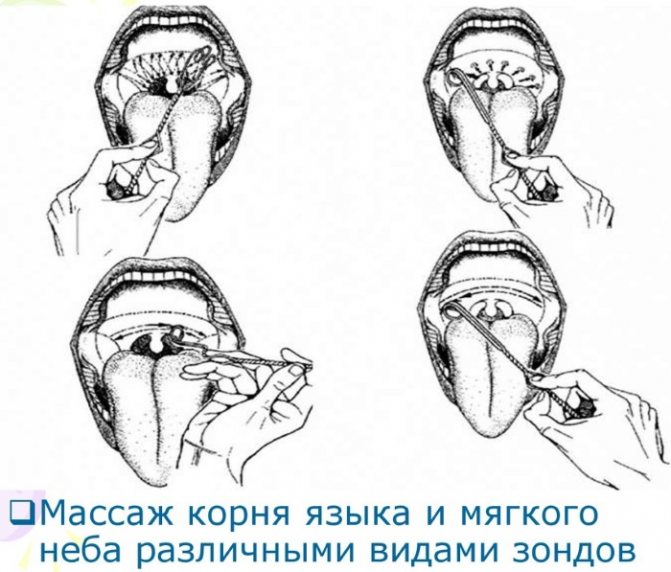
Treatment accelerates the process of restoration or initial production of sound pronunciation.
For this procedure, speech therapy instruments are used - probes, each of which differs not only in appearance, but also has a unique operating principle:
- thymus – used to pierce the tongue in order to awaken rhythmic muscle contractions, and then perform several rotational and oscillatory movements at a specific point for 4-6 s;
- a figure-eight probe is used to press on the tongue;
- the “sleigh” probe is a system of 3 devices that act on muscle fibers and nerve endings;
- the “hatchet” probe helps to slide and press;
- With a cross-shaped probe, you can simultaneously press and push away the tongue, causing muscle contractions.
Massage with a toothbrush
Speech therapy treatment can also be carried out using improvised means. At home, logomassage can be given to a child using a toothbrush.
During the procedure, the following types of movements are used:
- longitudinal transverse stroking;
- rubbing is circular, spiral;
- shock pressure;
- continuous vibration.
Instead of a toothbrush, a parent can use their perfectly washed finger. If the child resists the massage, you should try to distract his attention with something tasty, dipping a brush or finger, for example, in sour cream or jam.
One of the sets of exercises looks like this:
- Using the outer side of the brush without bristles, slowly move it 10 times from the center of the tongue to the periphery.
- The same number of movements, but now from the tip to the middle, without stimulating the root and without causing a gag reflex in the child.
- Brush along the entire length of the speech organ with light pressure along the lateral edges, aiming towards src=»https://healthperfect.ru/wp-content/uploads/2020/02/logomassazh-dlya-detey-6.jpg» class=» aligncenter" width="564″ height="531″[/img]
- Draw horizontal lines with a brush from the root of the tongue to the periphery.
- Make movements along a zigzag trajectory at least 7-10 times on the surface of the tongue and palate.
Massage with spoons
This method of influencing the articulatory apparatus is a type of facial massage. To give your child a logomassage with spoons, you need to prepare devices with a smooth surface and repeat all the exercises at least 7 times. From the age of 3-4 years, children can do exercises with spoons themselves under the strict supervision of their parents.
Logomassage for children at home begins with placing one cutlery in each hand of the child.
If the child is not yet ready for self-massage, an adult should:
- Use convex parts to stroke the lines of the forehead.
- Similar manipulations are performed on the cheeks using circular movements.
- Then, using the edge of a spoon, draw a line from bottom to top along the cheeks.
- Using the tips of the devices, rub your upper lip using stroking movements.
- Make kneading movements along the cheekbones, in the direction from the corners of the mouth to the temples.
Types of massage
Depending on the type of speech apparatus disorder, the age of the baby and his emotional state, the type of procedures and the intensity of the procedure are selected. The technique of classical speech therapy massage for children is based on the use of traditional techniques:
- stroking;
- rubbing;
- kneading;
- vibration impact.
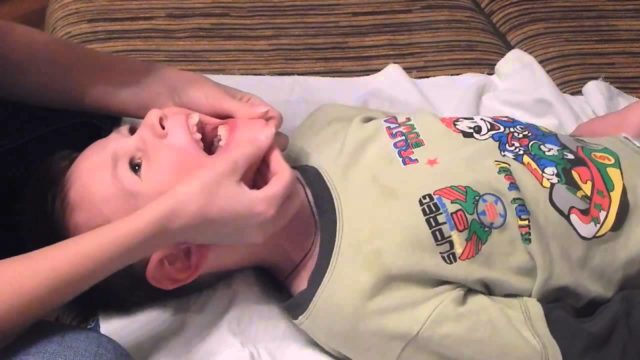
The procedure begins and ends with stroking - this is a prerequisite for a proper massage session. The strength of the effect depends on the pathology: if it is necessary to relax the muscles, then light strokes are used. To strengthen muscle tone, more active movements are necessary.
Acupressure involves influencing certain biologically active areas.
The hardware method is based on the use of vacuum and vibration devices. The author of the probe technology is E.V. Novikova, who used several types of probes in her work to massage the lips, tongue, and palate.
Read also…. Hardware method of facial massage
Doctors use several types of tools for speech therapy massage, such as:
- sleigh;
- crosses;
- hatchets;
- pushers;
- eights.
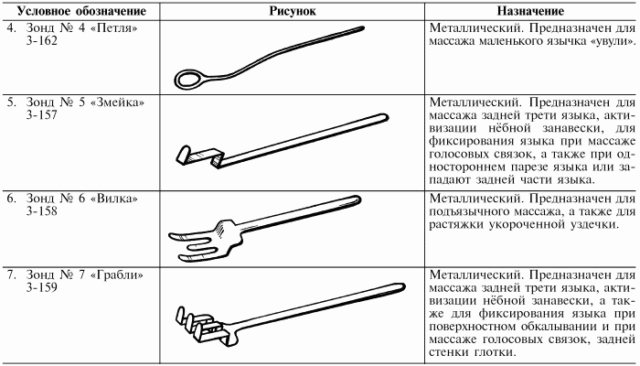
For children with cerebral palsy, the E. Arkhipova system is recommended. And for children of senior preschool and school age, a system of self-massage of the face and tongue has been developed.
Classic massage technique
At home, exercises and massage are performed from a sitting or lying position. The session begins with a massage of the collar area and shoulders. It is carried out by stroking the entire area from top to bottom. Then they move on to smooth turns of the child’s head in different directions: one hand of the mother holds the forehead, and the other lies on the back of the neck.
Relaxation of facial muscles is carried out by stroking with fingers. Direction of movement:
- from the central point of the forehead towards the temples;
- from the eyebrow line to the hairline;
- around eyes;
- from the bridge of the nose along the lower eyelid to the temples;
- from the corners of the lips to the earlobe.
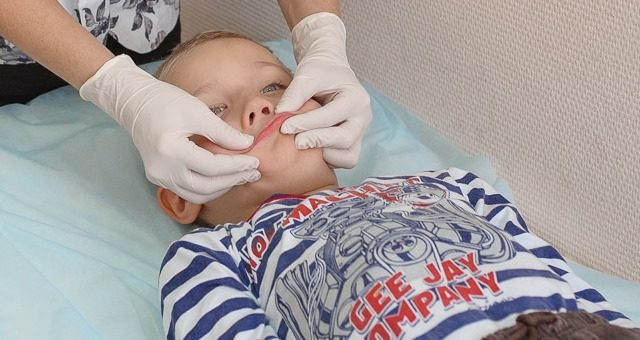
Each movement is repeated no more than 10 times. Relaxation of the lips is also carried out by stroking movements from the corners of the mouth 5-7 times, then smooth the area of the nasolabial folds with the tips of the index fingers. After this, massage the oral cavity. The technique for performing speech therapy massage of the tongue is as follows:
- using a napkin, take the tip of the tongue and move it in different directions;
- the left hand holds the tip of the tongue protruding from the mouth, and the right hand strokes the entire surface with a toothbrush;
- With light movements, they once again pass the entire surface of the tongue, after which they turn it to the sides.
Massaging the tongue should be done carefully, without using force or pressure. If the baby experiences discomfort, the treatment is stopped.
Activating massage
How to do an activating speech therapy massage:
- after preliminary relaxing massage, rhythmically squeeze the chin;
- then they move on to stroking the cheeks and cheekbones in a spiral with two fingers;
- after stroking there are active kneading of the worked area;
- this is followed by vigorous pinching of the cheeks.
Then the upper and lower lips are stroked. The bottom is worked with pats and vibration movements, using only the fingertips.
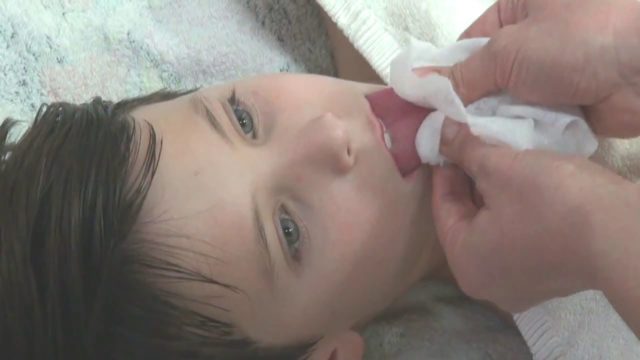
Massaging the tongue is carried out more intensively by rubbing and kneading. The direction of movement is from the root of the tongue to the tip. The sequence of techniques is as follows:
- rubbing along, across and in a spiral;
- compression of the sides of the tongue with pinching of the edges;
- patting the entire surface with a toothbrush.
The massage session is completed by rubbing the neck along the lower part to the earlobes, from the shoulder blades to the back of the head and over the entire surface.
Massaging with spoons
For the session you will need a couple of teaspoons. Speech therapy massage for a child begins with stroking the temple area with the convex part of a spoon. Circular movements are made clockwise with even and smooth pressure. Then they stroke the brow ridges from the inner edge to the outer, and along the lower eyelid to the bridge of the nose. Similarly, knead the chewing muscles and the area under the chin.
Stroking the cheeks with the convex side begins from the corners of the lips, gradually rising to the temples. The temples are passed in spiral movements, finishing the area with intense and rhythmic pressure. The lips are stroked and lightly kneaded.
Read also…. Rules of deep tissue massage
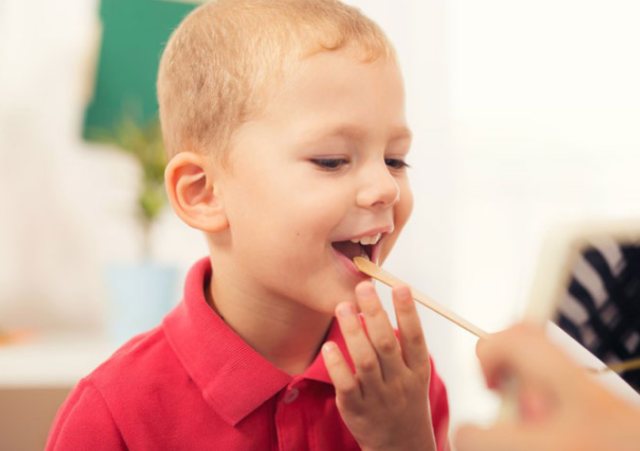
Massage with special spoons
Each technique is repeated up to 8 times. Facial massage for children using spoons may also include tongue work, but it should only be performed by a specialist. At home, there is a high chance of injury and muscle strain.
Self-massage
Training in speech therapy facial massage begins with working the ears for 10 counts. The ears are slowly pulled back and forth, then several circular movements are made along the cheeks and chin for a minute. The lower and upper eyelids are stroked for about 50 seconds, and the area around the eyes is passed in a circular motion. Start from the inner corner of the eyes and up to the upper eyelid. Apply up to 20 gentle pressures along the wings of the nose. Finally, you need to open your mouth and make 5 quick and sharp movements of the lower jaw to the right and left.
Warm up before massage
Speech therapists do not recommend starting a lesson immediately without warming up. This stage helps to create the right emotional mood in the child, warm up the facial muscles and prepare the speech apparatus. Warm-up should be done for several minutes every day.
It should consist of:
- breathing exercises;
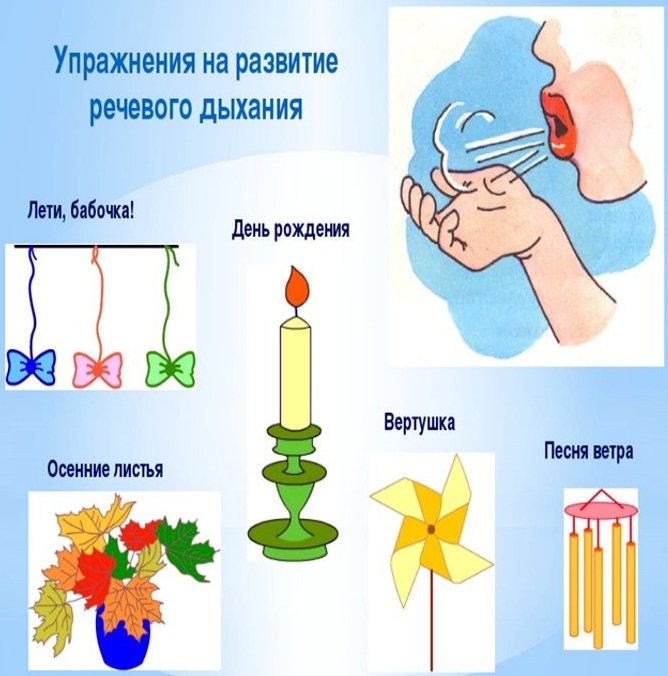
- simple exercises that activate facial muscles.
Among the methods of conducting speech therapy warm-up, gaming is considered the most effective. For example, a child is given the task of portraying a specific character from a fairy tale or cartoon, using only his facial expressions.
Speech therapy massage for dysarthria
Since this speech pathology in most cases is caused by microscopic damage to brain tissue, children with this diagnosis should be under the constant supervision of a speech pathologist-speech pathologist, study in a group or individually.
At home, logomassage is carried out according to the following algorithm:
- Alternately kneading and stroking the forehead with the right hand using zigzag movements from the hairline to the bridge of the nose, and with the left - according to the same principle, but stimulating the area from the center to the temples.
- Kneading the nose. The back of the child's head should rest against the massage therapist's hand while he creates a vibration effect due to progressive spiral movements from the wings to the base of the nose.
- Rubbing the cheekbones. This stage is performed with both hands at the same time. The massage therapist’s task is to work on areas from the lower jaw to the lower eyelid, working on areas of the ears and cheekbones. To do this, only the thumb and index fingers are used.
- Vibration of facial muscles. The massage therapist stands behind the child, placing his fingers on both sides of the lower jaw, and creates a soft vibration with quick pulsating movements.
- Tapping the nasolabial “triangle”. The massage is done with a bent index finger, moving clockwise.
A set of massage exercises
After the massage, it is advisable to move on to special exercises that not only consolidate the effect of the procedures, but also allow you to develop the speech apparatus, improve motor skills, and muscle motor function.
For lips
Exercises to improve lip mobility include:
- slow strokes from the middle to the corners;
- tightly closing the lips, after which they are lightly tapped. Repeat no more than 4 times;
- 3-4 spiral movements with the index finger. We lead from the middle of the lips to the corners. Performed with closed or parted lips;
- lips closed and extended forward;
- circular movements of the fingers in the corners of the mouth (5-7 repetitions);
- stroking with light pressure.
Movements should be aimed at stimulating muscle tissue, so it is advisable not to use too slow and soft strokes.
For language
Exercises for working with the language are divided into several complexes. The first is a classic massage, supplemented with vibration pats for 15 seconds.
The second begins with a relaxing massage, including:
- pressing on the submandibular fossa for 15 seconds;
- running your fingers from the middle of the chin to the edge of the cheekbone.
Then, using a napkin, hold the tongue by the tip with one hand and massage with the other. Movements - linear, spiral or circular. Direction:
- from the center to the tip and to the sides;
- across.
After this, they move on to rolling the tongue, pinching the edges, stroking the entire surface and stroking the sublingual area. The gums run in a horizontal direction.
The third set of exercises requires the use of a toothbrush. If the baby’s tongue is weak, then movements are carried out from the edges to the center. With tense muscles, techniques are performed from the center to the sides. The child is asked to stick out his tongue. If there is a pathology, then the tongue will deviate to the side after some time. The side of deviation is spastic, and it needs to be worked through stroking, gentle rubbing and vibration. The impact on her is minimal. The second side is flaccid and needs to be stimulated with strong pinching and pressure.
While working, the tongue is held with 2 fingers of the left hand. The back of the toothbrush is brushed in different directions using wavy, spiral and straight movements.
Read also…. Types and features of lymphatic drainage self-massage
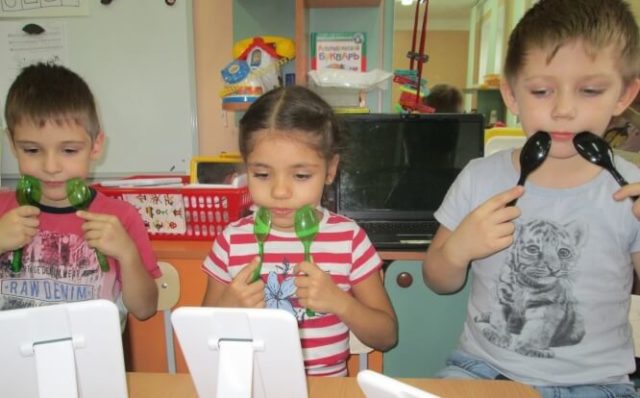
For the ears
There are many biologically active points on the ears, and exposure to them can improve hearing and vision, speech, memory, and concentration. Children's ear massage can be performed both by parents and by grown-up children.
When carrying out, be sure to follow the sequence:
- stretch the lobe and pull it down;
- stretch the curl;
- Rub the inner and outer surface well;
- twist the auricle, pulling back and forth, up and down;
- make several circular movements with your ears.
Exercises can be repeated several times a day, and the best time to do them is morning and evening.
For neck and hands
Neck massage is performed from a lying position. The head should lie below shoulder level. The neck is supported with one hand, and with the other, slow rotational movements of the head are made to the sides. Then smoothly turn the head to the right, left, forward and backward. No more than 5 repetitions for each side. After this, they move on to stroking the back surface from the hairline down and to the sides. Increasing the pressure, knead and rub from top to bottom.
Hand massage is recommended from the age of two months. Start by massaging the finger joints, then press each pad up to 10 times. The pressure force increases gradually. The presses are followed by circular movements across the palm and stroking from the center to the edges. Additionally, you can twist your fingers, make several flexion-extension movements, or massage from the base of your palm upward.
With hypotonicity of the tongue muscles
Violation of tone in children is often manifested by a deterioration in the functionality of the tongue muscles. Moreover, hypertonicity is considered a more common problem in speech therapy. Low fiber excitability occurs, as a rule, in local lingual muscles (for example, at the root or tip of the tongue, right or left).
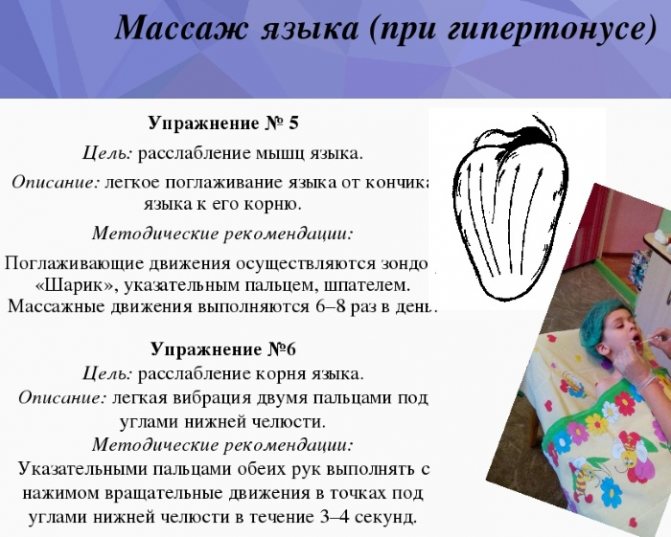
During a therapeutic massage indicated for hypotonicity of the tongue, you should pay attention to:
- direction of movements - they are produced from the root to the periphery;
- strength of reception - exercises should be stimulating in nature, be quite active and intense;
- rubbing and kneading are the preferred methods;
- increased salivation - before the massage, you should take steps in advance to eliminate excess fluid in the oral cavity, which often occurs with hypotonicity of the tongue.
When stuttering
Logomassage for children at home with stuttering is carried out to reduce the degree of tension in the facial muscles, activate speech centers and generally improve the condition. When choosing a suitable technique, speech therapists often give preference to the classical one.
When a child stutters, certain areas of the body are massaged to relax them. As a rule, these are tense neck muscles and the shoulder girdle, which help to increase the tone of the root of the tongue and the muscles of the lower jaw.
Kneading the muscles of the skull, chest, and back has a positive effect on articulation. Since with logoneurosis (this is the term doctors call stuttering) the goal is to activate metabolic processes, relax muscles and improve blood circulation, a complex effect on the child’s body is important.
In addition to classical techniques, specialists often resort to acupressure, which involves stimulating specific areas of the speech center and reducing the level of excitability. Treatment of logoneurosis with massage usually lasts 14-20 days. For the purpose of prevention, the course is carried out at least 2-3 times a year.
With ZRR
Logomassage for children with this diagnosis involves the use of traditional techniques. The muscles are affected by stroking, kneading and vibration.
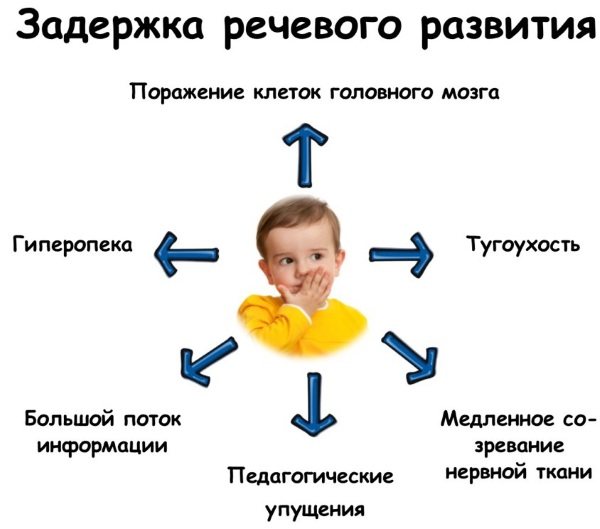
If speech development is delayed, you need to massage all parts of the face, repeating each movement 8-10 times:
- The forehead is stimulated with the palm, stroking movements directed from the middle to the temples, or with a vibrating massager from the eyebrows to the top.
- Massaging the cheeks should be a gentle pulling of the tissue from the corners of the mouth along the muscles directed towards the temples. Then they stroke the areas from the cheekbones to the chin.
- The area of the nose and nasolabial fold is treated with stroking and light vibration movements, moving to the corners of the mouth.
- The skin in the area above the upper lip should be gently stretched and rubbed with your thumbs.
How to do speech therapy massage yourself
Below are a few options that you can do at home yourself. The only thing is that we strongly recommend that you come to us once so that a speech therapist can check whether you are doing everything correctly. At the same time, the specialist will give recommendations specifically for your case.
Before doing speech therapy massage at home, you need to ventilate the room well. Another important point is the absence of any painful sensations - all manipulations should be painless.
Method of speech therapy massage according to E.Ya. Sizova
All manipulations are performed with clean, warm hands, at least twice a day (morning and evening). We take no more than 5-7 exercises. We begin and end the massage with stroking.
Lip exercises:
- We stroke the upper lip from the middle to the corners of the mouth, without going back (5-7 times). Movements are performed slowly, without pressure.
- We do the same with the lower lip;
- We close our lips and stroke them from the middle to the corners of the mouth (5-7 times).
- We lightly tap the lips from the middle to the corners of the mouth with both hands (3-4 times).
- We perform spiral movements along the lips from the middle to the corners of the mouth (3-4 times). They can be done on each lip separately or on closed lips. We do not touch the nasolabial triangle.
- “Duckling” - lips are closed and slightly extended. Lightly pinching the lips (5–7 times) is performed.
- “Acupressure in the corners of the lips” - fingers are placed on the corners of the lips and circular movements are made in one place (5-7 times).
- We close our lips and stroke them from the middle to the corners of the mouth (5-7 times).
For the lower jaw:
- Stroking with two fingers from the middle of the lower jaw to the cheekbones (5-7 times).
- Lightly tap with two fingers from the middle of the lower jaw to the cheekbones (5-7 times).
- Spiral movements with two fingers from the middle of the lower jaw to the cheekbones (5-7 times).
- Lightly pinching with your fingers from the middle of the lower jaw to the cheekbones (5-7 times).
- Stroking with two fingers from the middle of the lower jaw to the cheekbones (5-7 times).
For language:
- Stroking the protruding tongue and its lateral edges from center to middle (5–7 times).
- Patting the protruding tongue from the middle downwards with the second and third fingers horizontally (5–7 times).
- Tapping the protruding tongue and its lateral edges from center to middle (5–7 times).
- Spiral movements along the protruding tongue from the middle to the tip of the tongue (5-7 times).
- Pinching with light movements of the tip of the tongue (5-7 times).
- Stroking the protruding tongue and its lateral edges from center to middle (5–7 times).
For the palate:
- Stroking the palate from the teeth into the depths of the oral cavity to the soft palate (5–7 times).
- Lightly tap the palate from the teeth into the depths of the oral cavity to the soft palate (5–7 times).
- Zigzag movements (right-left) along the center line of the palate (5-7 times).
- Spiral movements along the central line of the palate (5–7 times).
- Stroking the palate from the teeth into the depths of the oral cavity to the soft palate (5–7 times).
Massage with a toothbrush
It requires little preparation. First of all, you need to buy the toothbrush itself. It should be clean and specifically designed for activities, not for brushing teeth. The bristle of the brush should be soft. Additionally, you will need to buy a bandage. Before class you will need to make several swabs. They are placed under the tongue to collect saliva, which will be actively released during the massage. It is important to change tampons with new ones on time. This will need to be done approximately every 2 minutes.
If the mother of a small child acts as a massage therapist, in order to relax the baby, you need to carry out all the exercises in active contact and communication. You can hum a song, tell a fairy tale, turn on classical music, put out your favorite toys. You need to adapt to your child.
All massage exercises are based on stroking and light vibration. With the help of the latter, it is possible to achieve relaxation of muscles that are in hypertonicity. Stroking is performed with spiral or circular movements. The pressure should not be strong.
In the case when speech therapy massage is performed on a child with cerebral palsy, you need to choose the right position. It could be like this:
- Lying on your back. Be sure to put a cushion under your head. The lower limbs should be bent at the knees.
- Embryo position.
- On the stomach. A cushion is placed in the chest area.
When performing massage for cerebral palsy, the massage technique is aimed at relaxing the muscles of the tongue. Additionally, the zygomatic muscles, nasolabial fold and submandibular muscles are affected.
Massage with spoons
An important condition for any massage is the cleanliness of the hands and instruments that the specialist will use during the procedure. Speech therapy massage with spoons is performed using ordinary cutlery. The only condition: the absence of patterns and other protruding elements on the spoon that can injure the mucous membrane.
To perform the massage, you will need to take 2 teaspoons and a few in reserve in case they fall on the floor.
Parents should understand that if there are problems with speech, the tongue needs massage to a greater extent, but without activating the entire speech apparatus it is impossible to achieve the desired result. All exercises are repeated 8 times. The technique for performing speech therapy massage with spoons is as follows:
- Stroking the child's temples with the convex side of a spoon. Movements should be directed clockwise.
- Lightly stroking the eye sockets with the rounded side of the spoon. The spoon is initially guided along the brow ridge towards the outer corner of the eye. The spoon is returned under the eye.
- The convex side of the cutlery is used to stroke the child’s cheeks.
- Spiral movements with the convex side of the device in the temple area. Finally, you can do a few light presses (you need to be very careful).
- The chewing and mental muscles are kneaded in a circular motion with the rounded side of the spoon.
- Use the tip of the cutlery to “scrape” along the upper and then the lower lip. After this, make frequent presses.
When performing a massage, most children experience excessive salivation, so work is necessary to overcome drooling:
- Teach children to chew and swallow well first by example. You can first perform a passive movement, take the child by the chin and, as it were, make chewing movements up and down several times a day. You can use a pacifier to teach the swallowing process. First, we put it in the baby’s mouth, then we press on it so that the liquid flows out, we pull it out and make massaging movements in the neck area until the child swallows. Try to give your baby less pureed food, and more often boiled and dried meat.
- Teach how to suck up saliva and often swallow saliva in one push before doing exercises.
It is important to end the massage session correctly. To do this, you need to stroke your face with your hands and praise the child. A favorite game or a small surprise in the form of a sticker is considered a good conclusion to the procedure. The baby will be guaranteed a positive attitude, and next time he will agree to the procedure without any problems, knowing that a reward will follow.
In the presence of deep pathologies (rhinolalia, cerebral palsy) affecting the speech apparatus, it is not recommended to attempt to correct the defect on your own. Each child, as well as his clinical picture, is individual and requires a special approach for speech development, correction and treatment of disorders.
With cerebral palsy
Massage of the organs of the articulatory system is necessary to stimulate the peripheral part of the speech analyzer and the frontal lobe of the central nervous system. The main task that speech therapists who work with such children set themselves is to improve the mobility of the tongue and lower jaw, the sensitivity of the palate, the inside of the cheeks, and the larynx.
For cerebral palsy, a probe massage involving the masticatory muscles and the orbicularis oris muscle is recommended. In case of low mobility of the tongue, short or deformed hyoid ligament, circular movements are made with alternating pressure on both sides of the lower jaw. It is also useful to stretch the lips to strengthen their tone, and tap the mylohyoid muscles from bottom to top.
Massage of the tongue with a probe should be preceded by identifying points, the impact of which provokes a gag reflex, spasms or convulsions.
Home massage results
Activities with your child allow you to:
- normalize the functioning of the maxillofacial muscles;
- reduce the severity of speech defects in difficult cases;
- activate muscle groups with insufficient contractility that take part in the articulation process;
- achieve better coordination of the child’s movements and strengthen the pharyngeal reflex.
Taking a course of logomassage for children, taking into account all the recommendations of a specialist, allows you to achieve a shift in the functioning of the articulatory apparatus and speech development even at home.
Speech therapy massage for children at home
If it is not possible to constantly practice with a specialist, then the logomassage technique can be mastered at home. To do this, you need to take special courses or ask for help from an experienced speech therapist. Professionals in their field will teach you a minimum set of techniques and exercises for the proper development of the speech apparatus. This experience will help parents more than once in the future.
How is massage performed at home?
- After the diagnosis is made, an individual plan of activities with the baby is drawn up. Adults choose appropriate exercises. Thus, with hypotonicity of the facial muscles, completely different tactics will be used than with uncontrolled salivation.
- The room for the procedure is being prepared. It needs to be removed and ventilated.
- Instruments for the procedure (toothbrush, spatula, spoons) are thoroughly washed and treated with boiling water.
- If the procedure is performed in the oral cavity, you must wear clean medical gloves.
- The parent washes their hands with soap and treats them with an alcohol-based antiseptic.
- The child is in a semi-sitting position with a soft cushion under the neck.
- The best movements: stroking, rubbing, light vibration. It is necessary to monitor the baby's mood. Massage is not performed if the baby is not in a good mood. The time for logomassage is adjusted according to the child’s age. If the baby has no signs of allergies, you can use aromatic oils (lavender oil - soothes, lemon oil - tones and triggers brain activity). For infants, it is more advisable to use powders rather than oils.
- At the end of the session, it is important to praise the baby and say pleasant words to him. You can play your favorite games with him. Such actions will form a friendly attitude towards classes in the child’s mind.
Let's give an example of simple massage exercises that help strengthen articulatory muscles. And it’s easy to do with your child at home.
All movements are repeated eight to ten times and carried out “from the center” to the periphery. Includes stroking, kneading, rubbing and pinching.
- Lightly stroking the upper part of the shoulder girdle (from bottom to top).
- Stroking the chin and lower face (from the center to the ears)
- Lip massage: stroking alternately the upper and lower lips in the direction from the middle to the corners. Stroking the nasolabial folds (in the direction from the corners of the lips to the nose). Then lightly tingle the lips from the middle to the corners.
- Face massage. Stroking from the middle to the temples of the forehead, then from the middle to the hair. Stroking eyebrows, cheeks. Kneading the cheek and zygomatic muscles - (circular movements in a spiral from the center to the ears). And we finish by pinching the cheeks.
- Tongue massage. Includes soft circular movements to knead the tongue from the tip to the middle (front and along the side edges). Then the tongue is pulled (holding the tip) - up, down, left, right. And we “comb” the tongue with a toothbrush using movements from the depths to the bottom. We finish the massage by kneading - squeezing the tongue from the sides in the direction “from the sides to the middle.”
Children's speech therapy massage at home gives good results in combination with articulation gymnastics. And if you add breathing exercises, physiotherapy, learning specialized games and tongue twisters, and maternal care, there is simply amazing progress in speech development. Doctors advise parents not to despair, but to study logomassage techniques. This invaluable experience will help out a mother or father more than once, even while raising a healthy baby.

